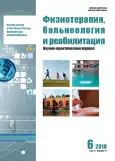The main clinical symptoms in patients with posterior vaginal wall prolapse and modern non-drug technologies for its relief
- Authors: Epifanov V.A.1, Illarionov V.Y.2, Zhumanova E.N.2,3
-
Affiliations:
- Moscow State University of Medicine and Dentistry named after A.I. Evdokimov
- Central State Medical Academy of Department of Presidential Affairs
- Clinical Hospital 1 of MEDSI Group of Companies Joint-Stock Company
- Issue: Vol 17, No 6 (2018)
- Pages: 332-338
- Section: Original studies
- URL: https://journals.rcsi.science/1681-3456/article/view/59950
- DOI: https://doi.org/10.17816/1681-3456-2018-17-6-332-338
- ID: 59950
Cite item
Full Text
Abstract
Background. Rectocele is one of the leading causes of abnormal position and dysfunction of the pelvic floor and rectum.
Objective: to develop and scientifically substantiate the use of a rehabilitation complex, including general magnetotherapy, electromyostimulation with biofeedback in combination with fractional microablative CO2 laser therapy in patients of different age groups with rectocele after surgery.
Methods. The article presents the results of treatment of 100 women with rectocele, who were divided into main and control groups, within each group, depending on their age, they were divided into 2 subgroups: women of childbearing age were included in subgroup A, and women of peri- and menopausal age were included in subgroup B. Patients of the main group in the early postoperative period after plastic surgery for rectocele (from 1 day) were given a course of General magnetotherapy and in the late postoperative period (one month after the operation) a set of measures was performed, consisting of a course of electromyostimulation with biological connection of the pelvic floor muscles 2 intravaginal procedures of fractional microablative CO2 laser therapy at intervals of 4–5 weeks. Patients of the control group after surgical treatment of rectocele in the late postoperative period received symptomatic therapy, including painkillers and spasmolytics and a set of Kegel exercises.
Results. Significant improvements in postoperative treatment were observed in patients of the main group: pelvic pain and periodic pain in the lower abdomen and lower back disappeared in 100% of cases; the main complaints related to violation of rectal emptying and urination were preserved in no more than 5–7% of cases, sexual complaints — in 5%; in 95% of cases, general, vegetative and pre-climacteric complaints disappeared.
Conclusion. As a result of the conducted research, it is shown that under the influence of the developed rehabilitation complex, regardless of age, there was a highly reliable dynamics of all complaints due to the influence of physical factors included in it on various pathogenetic links in the development of the disease.
Full Text
##article.viewOnOriginalSite##About the authors
Vitaly A. Epifanov
Moscow State University of Medicine and Dentistry named after A.I. Evdokimov
Email: ekaterinazhumanova@yandex.ru
MD, Professor
Russian Federation, 20/1, Delegatskaya street, Moscow, 127473Valery Y. Illarionov
Central State Medical Academy of Department of Presidential Affairs
Email: ekaterinazhumanova@yandex.ru
MD, Professor
Russian Federation, Marshala Timoshenko str.,19, Moscow, Russia, 121359Ekaterina N. Zhumanova
Central State Medical Academy of Department of Presidential Affairs; Clinical Hospital 1 of MEDSI Group of Companies Joint-Stock Company
Author for correspondence.
Email: ekaterinazhumanova@yandex.ru
ORCID iD: 0000-0003-3016-4172
MD, PhD
Russian Federation, Marshala Timoshenko str.,19, Moscow, Russia, 121359; MoscowReferences
- Apolikhina IA, Dikke GB, Kochev DM. Sovremennaya lechebno-profilakticheskaya taktika pri opushchenii i vypadenii polovykh organov u zhenshchin. Znaniya i prakticheskiye navyki vrachey. (Conference proceedings) Materialy XXVI Mezhdunarodnogo kongressa s kursom endoskopii “Novyye tekhnologii v diagnostike i lechenii ginekologicheskikh zabolevaniy”. Moscow; 2013. Р. 34. (In Russ).
- Vasin RV, Filimonov VB, Vasina IV. Genital prolapse: contemporary aspects of surgical treatment (literature review). Experimental & Clinical urology. 2017;(1):104-115. (In Russ).
- Ginekologiya. Natsional’noye rukovodstvo. Ed by VI Kulakov, GM Savel’yevа, IB Manukhin. Moscow: GEOTAR-Media; 2009. Р. 404-405. (In Russ).
- Zhuravleva AS. Printsipy vybora khirurgicheskikh tekhnologiy dlya korrektsii oslozhnennykh form prolapsa genitaliy i otsenka ikh effektivnosti. [dissertation abstract] Moscow; 2009. 22 р. (In Russ). Avalable from: https://search.rsl.ru/ru/record/01003477617.
- Orazov MR, Khamoshina MB, Nosenko EN, et al. The pathogenetic mechanisms of the formation of pelvic organ prolapse. Akusherstvo i ginekologiia: novosti, mneniia, obuchenie. 2017;(3):108-116. (In Russ).
- Hermieu JF, Le Guilchet T. [Genital prolapse and urinary incontinence: a review. (In French)]. J Med Liban. 2013;61(1):61-66. doi: 10.12816/0000402.
- Paraiso MF, Barber MD, Muir TW, Walters MD. Rectocele repair: a randomized trial of three surgical techniques including graft augmentation. Am J Obstet Gynecol. 2006;195(6):1762-1771. doi: 10.1016/j.ajog.2006.07.026.
- Radzinskiy VE, Durandin YuM, Gagayev ChG, et al. Perineologiya: bolezni zhenskoy promezhnosti v akushersko-ginekologicheskikh, seksologicheskikh, urologicheskikh, proktologicheskikh aspektakh. Ed by VE Radzinskiy. Moscow; 2006. 336 р. (In Russ).
- Groshilin VS, Shvetsov VK, Uzunyan LV. Preimushchestva ispol’zovaniya individual’nykh kriteriyev vybora metoda lecheniya rektotsele. Koloproktologiia. 2016;(S1):23а-23а. (In Russ).
- Smirnov AB, Khvorov VV. Sravnitel’naya otsenka metodov khirurgicheskoy korrektsii rektotsele N.I. Pirogov Journal of Surgery. 2006;(10):22-26. (In Russ).
- Khitar’yan AG, Prokudin SV, Dul’yerov KA. Sovershenstvovaniye diagnosticheskogo obsledovaniya i khirurgicheskoy taktiki lecheniya bol’nykh rektotsele. Meditsinskii vestnik Yuga Rossii. 2016;(1):77-83. (In Russ).
- Tigiyeva AV. Nesostoyatel’nost’ tazovogo dna u zhenshchin reproduktivnogo vozrasta. [dissertation abstract] Moscow; 2014. 20 р. (In Russ). Avalable from: https://search.rsl.ru/ru/record/01005556370.
- Fomenko OYu, Shelygin YuA, Popov AA, et al. The functional state of the pelvic floor muscles in patients with rectocele. Russian Bulletin of Obstetrician-gynaecologist. 2017;17(3):43-48. (In Russ). doi: 10.17116/rosakush201717343-48.
- Zalud I, Maulik D, Conway C. Pelvic blood flow in postmenopausal women: colors. power Doppler. Ultrasound Obstet Gynecol. 1996;8(Suppl 1):8-14.
- Epifanov VA, Korchazhkina NB. Meditsinskaya reabilitatsiya v akusherstve i ginekologii. Moscow: GEOTAR-Media; 2019. 504 р. (In Russ).
- Abramov Y, Gandhi S, Goldberg RP, et al. Site-specific rectocele repair compared with standard posterior colporrhaphy. Obstet Gynecol. 2005;105(2):314-318. doi: 10.1097/01.AOG.0000151990.08019.30.
Supplementary files








